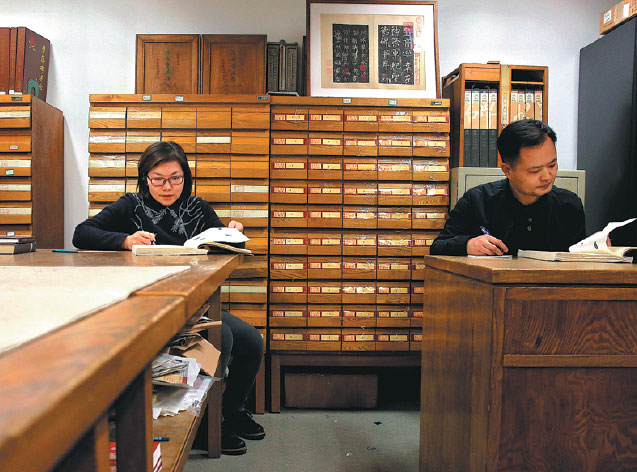 |
|
Hu Huiping (left) and Zhao Aixue work as fulltime researchers at the National Library of China, handling the world’s biggest collection of oracle bones. [Photo by Jiang Dong/China Daily] |
Research work
"We were cheered up immensely by that successful (UNESCO) bid," says Hu Huiping, a researcher with the National Library of China in Beijing. "But the day-to-day work hasn't really changed despite this."
She spends her days researching, studying and cataloging oracle bones.
Even though she graduated from college 15 years ago, the 41-year-old researcher says she still feels like a student stuck in a study room at her small office in the Beijing library.
"It's a job that involves sitting on a cold bench," she says. "You need patience and diligence to overcome loneliness."
Hu attributes her patience to the hope that she might one day grasp the full picture behind the Shang Dynasty through its relics.
"I wanted to understand what the Shang era was like," Hu says. "But, maybe I've only caught a glimpse of what life was like then after these 15 years."
When Hu first entered the warehouse housing the oracle bones alone in the basement of the library, she was faced with a huge hoard-with no systematic catalog in place.
"I started to catalog them from 'No 00001 oracle bone'," Hu says, proudly. "Now, less than 10,000 items are on my waiting list."
According to library statistics, there are 35,651 individual oracle bones housed in the library, making it the world's biggest repository of these precious documents.
"It's much more complicated than cataloging a book," she explains further. "For one single piece of bone, you have to rifle through lots of files to make sure its explanation, time, usage, and cultural context are all properly recorded. It's a lot of work."
In 2011, Hu was finally joined by her colleague Zhao Aixue. They remain the only two full-time researchers devoted to cataloging the oracle bones in the library.
According to Zhao, the status of oracle bones has been upgraded in recent years.
"For a long time, they used to be categorized as cultural relics rather than documents," he recalls. "That downplayed their significance as written history."
After many academic discussions, the oracle bones were included in the larger list of key national ancient books and documents for the first time in 2013, which was a pivotal moment for research and development, and presented a solid foundation for the UNESCO bid.